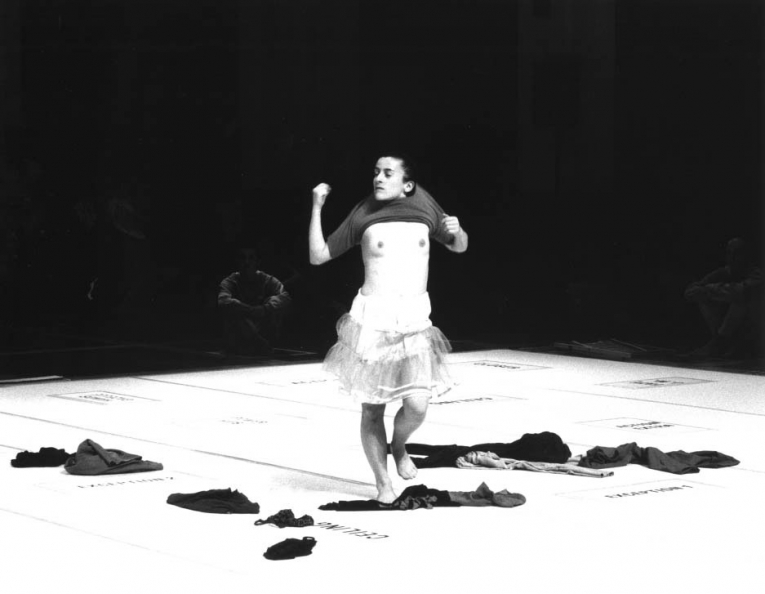Premiere May 11th-12th 1999 - Cabot Hall, Canary Wharf, London, UK. Written and Directed: La Ribot. Direction Assistant: Juan Dominguez. Performers and Codified material creators: Juan Domínguez, Rachel Krische, La Ribot, Marc Smith. Time keeper: Emma Wilson. La Sylphide: chosen at each place. Extras: 6 chosen at each place. Music: Rubén Gonzales. Sign-language tutor: Charlotte Moulton-Thomas. Technical Director & Lighting Design: Emma Wilson. Costume: Blue Farrier. Photos: Pau Ros. Stage Design: Pep Sala. Executive producer: Eduardo Bonito. Assistant: Jo Hughes. Produced by : La Ribot. An Artsadmin project. Commissioned by Dance 4, Nottingham and Canary Wharf Arts and Events, London. Produced by Bonito & Compri, London, Calvo Cantero Producciones, Madrid and PX3 Festival, Pavia in co-production with Theatre Arsenic, Lausanne. Supported by London Arts Board, The Spanish Embassy, London and Comunidad de Madrid. Developed with the assistance of Keidan/Ugwu, London and The Place Choreodrome, London. Premiere May 11th-12th 1999 - Cabot Hall, Canary Wharf, London, UK. Written and Directed: La Ribot. Direction Assistant: Juan Dominguez. Performers and Codified material creators: Juan Domínguez, Rachel Krische, La Ribot, Marc Smith. Time keeper: Emma Wilson. La Sylphide: chosen at each place. Extras: 6 chosen at each place. Music: Rubén Gonzales. Sign-language tutor: Charlotte Moulton-Thomas. Technical Director & Lighting Design: Emma Wilson. Costume: Blue Farrier. Photos: Pau Ros. Stage Design: Pep Sala. Executive producer: Eduardo Bonito. Assistant: Jo Hughes. Produced by : La Ribot. An Artsadmin project. Commissioned by Dance 4, Nottingham and Canary Wharf Arts and Events, London. Produced by Bonito & Compri, London, Calvo Cantero Producciones, Madrid and PX3 Festival, Pavia in co-production with Theatre Arsenic, Lausanne. Supported by London Arts Board, The Spanish Embassy, London and Comunidad de Madrid. Developed with the assistance of Keidan/Ugwu, London and The Place Choreodrome, London.
EN
Show/ Dance/ Theater
El Gran Game, 1999, is an hour-long choreographic experiment in random composition. Its “players” are La Ribot herself, three other dancers and seven “extras”: residents of whichever city the performance is staged in, who work with La Ribot to learn their parts. The intricately structured game is performed on a floor marked with a large white square. Stuck to the floor with black tape are cards bearing texts, and these provide starting points for different actions. The periodic throwing of dice determines which text will be operational, so multiple repetitions are a strong possibility. As the work progresses, texts are periodically stripped from the floor, and when the board is clean the dancers are left with nothing to do: the game is over.
The piece’s choreography explores ideas of translation and codification, and uses data from a research project exploring similarities between British Sign Language and the codes of classical dance. The dancers “translate” certain texts using hybrid hand and arm movements inspired both by the shapes and dynamics of BSL and those of classical dance. At a given point in the game the dancers pin clothes pegs to their backs in lieu of sylphs’ wings and perform movements from the 1836 ballet La Sylphide (the first instance of encoded classical dance) whilst whistling the music. Other subjects for “translation” include gestures such as folding and unfolding clothes, or getting dressed and undressed.
El Gran Game has a “cool” structural basis but in practice, as the details above suggest, its babel of dance languages is full of humour and eccentricity. One possible dice-throw leads to a high-energy dressing-up-cum-striptease game called exception!, which requires the dancers to dress and undress without stopping whilst following a mathematically determined scheme and staying in rhythm – an impossible challenge rendered doubly funny by the fact that the dancers’ frantic efforts are largely performed in the nude.
